|
|
|
Sort Order |
|
|
|
Items / Page
|
|
|
|
|
|
|
| Srl | Item |
| 1 |
ID:
144081
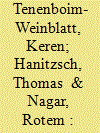

|
|
|
|
|
| Summary/Abstract |
This article presents a general framework for deconstructing and classifying conflict news narratives. This framework, based on a nuanced and contextual approach to analyzing media representations of conflict actors and events, addresses some of the weaknesses of existing classification schemes, focusing in particular on the dualistic approach of the peace journalism model. Using quantitative content analysis, the proposed framework is then applied to the journalistic coverage in the Israeli media of three Middle-Eastern conflicts: the Israeli–Palestinian conflict, the conflict surrounding Iran's nuclear program, and the Syrian civil war. The coverage is examined in three leading news outlets – Haaretz, Israel Hayom, and Ynet – over a six-month period. Based on hierarchical cluster analysis, the article identifies four characteristic types of narratives in the examined coverage. These include two journalistic narratives of violence: one inward-looking, ethnocentric narrative, and one outward-looking narrative focusing on outgroup actors and victims; and two political-diplomatic narratives: one interactional, and one outward-looking. In addition to highlighting different constellations of points of view and conflict measures in news stories, the identified clusters also challenge several assumptions underlying existing models, such as the postulated alignment between elite/official actors and violence frames
|
|
|
|
|
|
|
|
|
|
|
|
|
|
|
|
| 2 |
ID:
144083


|
|
|
|
|
| Summary/Abstract |
Suicide attacks continue to plague a multitude of conflict zones. However, the scholarly literature on the phenomenon has yet to produce a theory that explains why militant organizations at different stages of development, facing dissimilar enemies, and situated in unique conflict environments adopt suicide attacks. Moreover, the suicide-attack phenomenon now presents an intriguing puzzle. While most militant organizations fail to achieve their core political ends or ‘outcome goals’, organizations that employ suicide attacks are even less likely to succeed. Still, organizations have adopted suicide attacks at increasing rates. Given their ineffectiveness in precipitating outcome-goal success, why do organizations continue to adopt suicide attacks? Like all organizations, militant organizations share two common aims: (1) to survive and (2) to achieve outcome goals. As martyrdom operations often fulfill the ideological or cultural expectations of certain identity groups, representative organizations may adopt suicide attacks to expand constituent support or enhance status within a particular political landscape. Further, organizations can conduct suicide attacks to signal ideological solidarity with fellow militant organizations. This article analyzes an original large-N dataset of militant organizations alongside an original database of over 5,000 suicide attacks, and evaluates numerous case examples. The results demonstrate that militant organizations across regions and over time have adopted suicide attacks in order to gain supporters, promote organizational longevity, and boost or preserve status.
|
|
|
|
|
|
|
|
|
|
|
|
|
|
|
|
| 3 |
ID:
144086
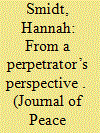

|
|
|
|
|
| Summary/Abstract |
Do international election observers deter or spur violence after election day? This article argues that only when conceptually and empirically distinguishing between violence by governments and opposition groups, can we assess the impact of international election observation. Disaggregating post-electoral violence uncovers that observers can deter governments from using force, but they have the opposite effect on opposition groups. When expecting criticism from observers, opposition leaders can easily deny their responsibility for violence by individual party militants, while weaponry and official insignia betray police and military involvement in violence and force the government to bear command responsibility. Governments also anticipate higher international costs for engaging in post-electoral violence than opposition groups, which are not usually targets of international punishment. On the other hand, international election observers unintentionally incite opposition groups to organize violence, as opposition groups seek to benefit from international attention and support that come with the presence of observers. Observers’ exposure of fraud reverses this differential effect: because governments expect international costs for election rigging anyway, observers cannot deter repression after highly fraudulent elections. But their alertness to electoral malpractice alleviates opposition groups’ incentives for post-electoral violence. Using data on 230 state-wide elections in Africa from 1990 to 2009, the analysis supports the observable implications of this argument. The findings of this article imply that international election observation missions make the post-electoral environment more peaceful when it comes to government repression after non-fraudulent elections. But observers ought to develop greater local expertise to identify opposition grievances before these groups resort to violence and be attentive to the possibility of increased repression after exposing cheating.
|
|
|
|
|
|
|
|
|
|
|
|
|
|
|
|
| 4 |
ID:
144085
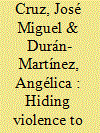

|
|
|
|
|
| Summary/Abstract |
In 2012, the two major street gangs in El Salvador, Mara Salvatrucha 13 and Barrio 18, struck a truce credited with reducing homicide rates by more than 50% in one year. Although the gang truce held for only 18 months, the significant reduction in homicides puzzled observers that believed youth gangs were unable to coordinate violence, especially considering that previous and similar efforts aimed at striking agreements did not achieve similar results. This article addresses a question posed by the puzzle of the Salvadoran truce’s success: under what conditions do negotiations between or with criminal organizations effectively reduce criminal violence? By comparing truces and criminal pacts in El Salvador and in Medellin, Colombia, we argue that criminal pacts can reduce homicides when (a) they directly involve the state as an administrator of incentives to reduce violence and (b) criminal organizations have achieved organizational cohesion and leadership that facilitate territorial control and strategic dependability. These conditions allow organizations to regulate violence. Our argument highlights the importance of how violence is performed and, more importantly, its visibility, to fully understand criminal behavior within pacts. It also points to potential lessons for countries seeking alternatives to reduce criminal and political violence in Latin America and elsewhere.
|
|
|
|
|
|
|
|
|
|
|
|
|
|
|
|
| 5 |
ID:
144088
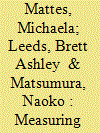

|
|
|
|
|
| Summary/Abstract |
This article introduces the CHISOLS (Change in Source of Leader Support) dataset, which identifies which leadership changes within countries bring to power a new leader whose primary support is drawn from different societal groups than those who supported her predecessor. The dataset covers all countries of the world with populations greater than 500,000 from 1919 to 2008. We discuss the underlying rationale of our data collection, provide some brief information about the coding rules and procedures, and share some descriptive statistics. We find that changes in sources of leader support are more common in democracies than non-democracies, but also that changes in sources of leader support often occur without irregular leader transitions or large institutional changes, even within non-democracies. CHISOLS can be productively combined with other datasets like POLITY, Archigos, and DPI that provide information about political institutions, modes of leader transition, and placement on a left–right policy continuum, but CHISOLS also provides something new that was not previously available. These data allow researchers to study the extent to which different types of policy change are associated with all leader transitions, with changes in political institutions, or with changes in the set of interests that leaders most closely represent; CHISOLS facilitates comparing the effect of leaders, interests, and institutions on policy change across a wide spatial temporal domain.
|
|
|
|
|
|
|
|
|
|
|
|
|
|
|
|
| 6 |
ID:
144089


|
|
|
|
|
| Summary/Abstract |
Violence against civilians is not the only tool among the arsenal of terrorists; it is only one of many. Up until now, there did not exist any quantitative data on the different strategies adopted by terror groups that measured the group’s popularity or its public support. The Reputation of Terror Groups dataset (RTG) addresses this void. To understand which terror groups build different types of reputation, to analyze the consequences of reputation building and how reputation changes with and influences conflict dynamics, we need to be able to measure the loaded concept of reputation. RTG is the first systematic measure for the reputation of terror groups across countries or time. The dataset includes 443 terror groups operating across 31 years, which makes a total of 2,641 observations. The large sample size of the RTG dataset allows comparisons of popularity among groups. Additionally, the dataset adopts a multivariable approach by examining multiple aspects of both positive and negative reputation building. Another novelty of the dataset is its measure of reputation with regard to each target, mainly its constituency and target audience. The RTG data can help us come up with new and novel ways of understanding terror groups, and contribute to bridging the gap between micro- and mezzo-level studies in the literature by showing how terror groups adopt different strategies in their constituency and target audience to pursue their goals. In this article, we give an overview assessment of the RTG dataset, display some interesting trends in the data, and explain the data collection procedure, its challenges, and its limitations.
|
|
|
|
|
|
|
|
|
|
|
|
|
|
|
|
| 7 |
ID:
144084
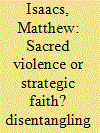

|
|
|
|
|
| Summary/Abstract |
Why are religious conflicts more violent than non-religious conflicts? Research has argued that religion pushes partisans toward violence. However, existing research suffers from widespread problems of measurement validity and fails to confront the possibility of endogeneity in the relationship between religion and violence. This article develops a more precise measure of the relevance of religion to conflict based on the use of religious rhetoric by political organizations. With this approach in mind, this article disentangles the causal sequence linking religious rhetoric and violence using annually coded data on the rhetoric of 495 organizations worldwide from 1970 through 2012. The analysis finds a strong general correlation between religious rhetoric and violence. However, past use of religious rhetoric does not increase the likelihood that an organization will participate in violence or the overall intensity of conflict. On the contrary, previous participation in violence makes an organization more likely to adopt religious rhetoric for mobilization. Indeed, religious rhetoric becomes more likely as violence increases in intensity and conflict continues for longer periods of time. These findings suggest that violent actors adopt religious rhetoric to solve the logistical challenges associated with violence, including access to mobilizing resources and recruitment and retention of members. This article contributes to the study of religious conflict by providing evidence of endogeneity in the relationship between religion and violence and highlighting the need for temporally sensitive measures of religious mobilization.
|
|
|
|
|
|
|
|
|
|
|
|
|
|
|
|
| 8 |
ID:
144087


|
|
|
|
|
| Summary/Abstract |
If a government is facing an armed uprising, why doesn’t it confiscate all privately owned weapons? When and where is forcible disarmament most likely to occur? Can forcible disarmament reduce rebel activity? To establish a monopoly on the use of force, a government must either convince its citizens not to rebel, or remove their capacity to do so. Existing literature has left this choice – between punishment and disarmament – virtually unexplained. Most existing research focuses on disarmament in the context of post-conflict stabilization, rather than forcible disarmament during war. I introduce a mathematical model of irregular warfare, in which government and rebel forces seek a monopoly on violence. The model shows that disarmament occurs mainly in ‘hard cases’, where otherwise strong governments are unable to punish opponents or reward supporters. I test these claims with declassified archival data on counterinsurgency in the Soviet North Caucasus. The data confirm that disarmament was most likely where the government’s coercive leverage was limited – due to poor intelligence and potential backlash from collateral damage. In these otherwise challenging circumstances, disarmament significantly reduced rebel violence – short-term and long-term, locally and region-wide. By limiting the potential coercive resources under the opposition’s control, disarmament can render rebels unable to sustain a campaign of violence against the state.
|
|
|
|
|
|
|
|
|
|
|
|
|
|
|
|
| 9 |
ID:
144082
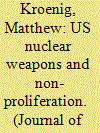

|
|
|
|
|
| Summary/Abstract |
According to a widespread conventional wisdom, there is a link between US nuclear weapons and nuclear proliferation and, therefore, in order to prevent the spread of nuclear weapons to other states, the US government must first make changes to its own nuclear arsenal. This article challenges the notion that US nuclear posture has a significant bearing on the proliferation and non-proliferation behavior of other states. Contrary to the received wisdom in policy circles, this article maintains that state decisions on nuclear non-proliferation issues are driven by a range of other security, economic, and political factors and, once these considerations are taken into account, there is little if any remaining variance to be explained by US nuclear posture. Using a dataset on US nuclear arsenal size from 1945 to 2011, this article examines the relationship between the size of the US nuclear arsenal and a variety of nuclear non-proliferation outcomes. It finds that there is no evidence of a relationship between the size of the US arsenal and: the exploration, pursuit, or acquisition of nuclear weapons by other states; the provision of sensitive nuclear assistance to non-nuclear weapon states; and voting on non-proliferation issues in the United Nations Security Council. The results are robust to alternate conceptualizations and measurements of US nuclear weapons and in various subsamples of data. This article breaks new ground on an empirical research agenda on how the nuclear policies and postures of the major nuclear powers affect the spread of nuclear weapons and has important implications for nuclear security policy.
|
|
|
|
|
|
|
|
|
|
|
|
|
|
|
|
|
|
|
|
|